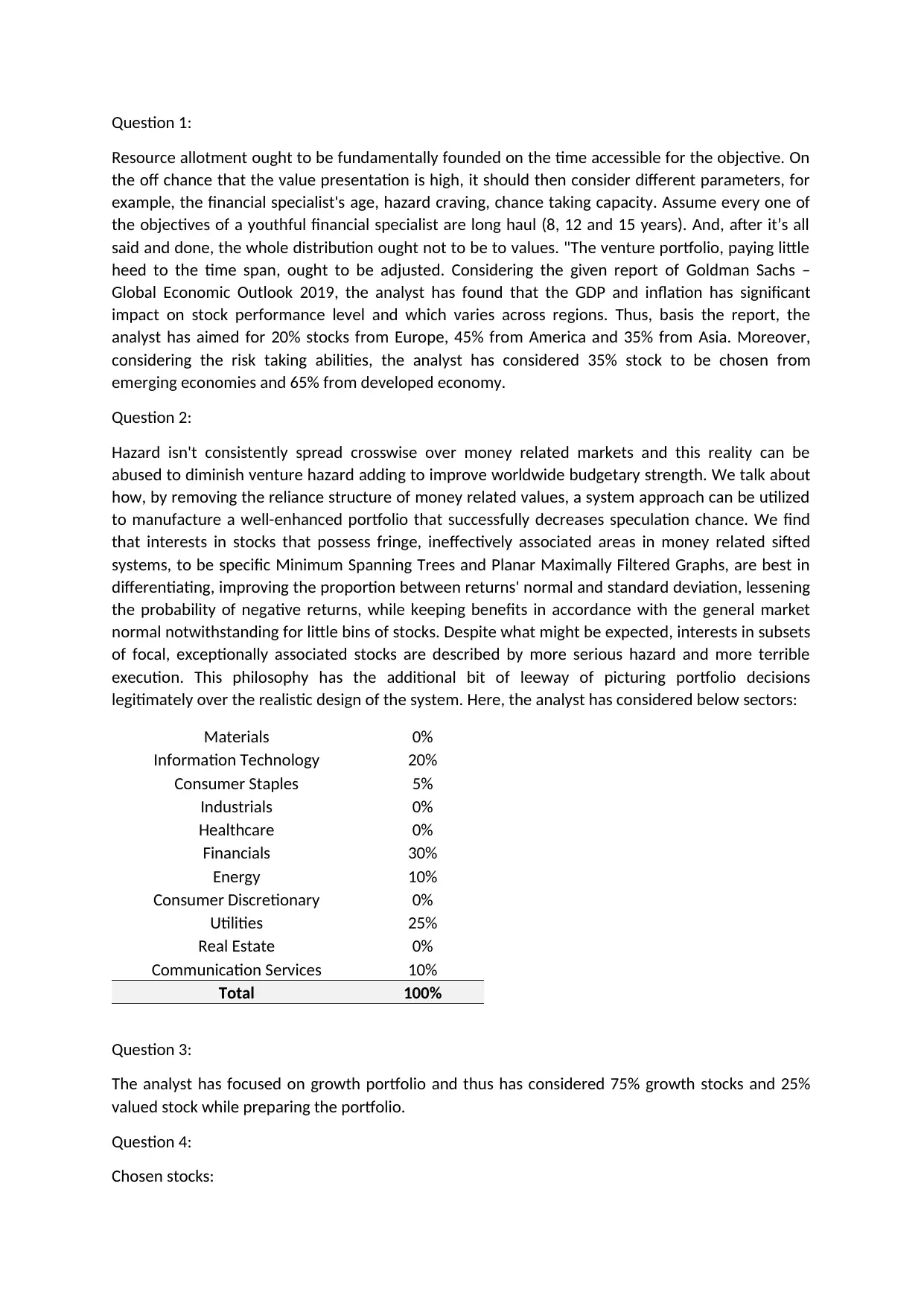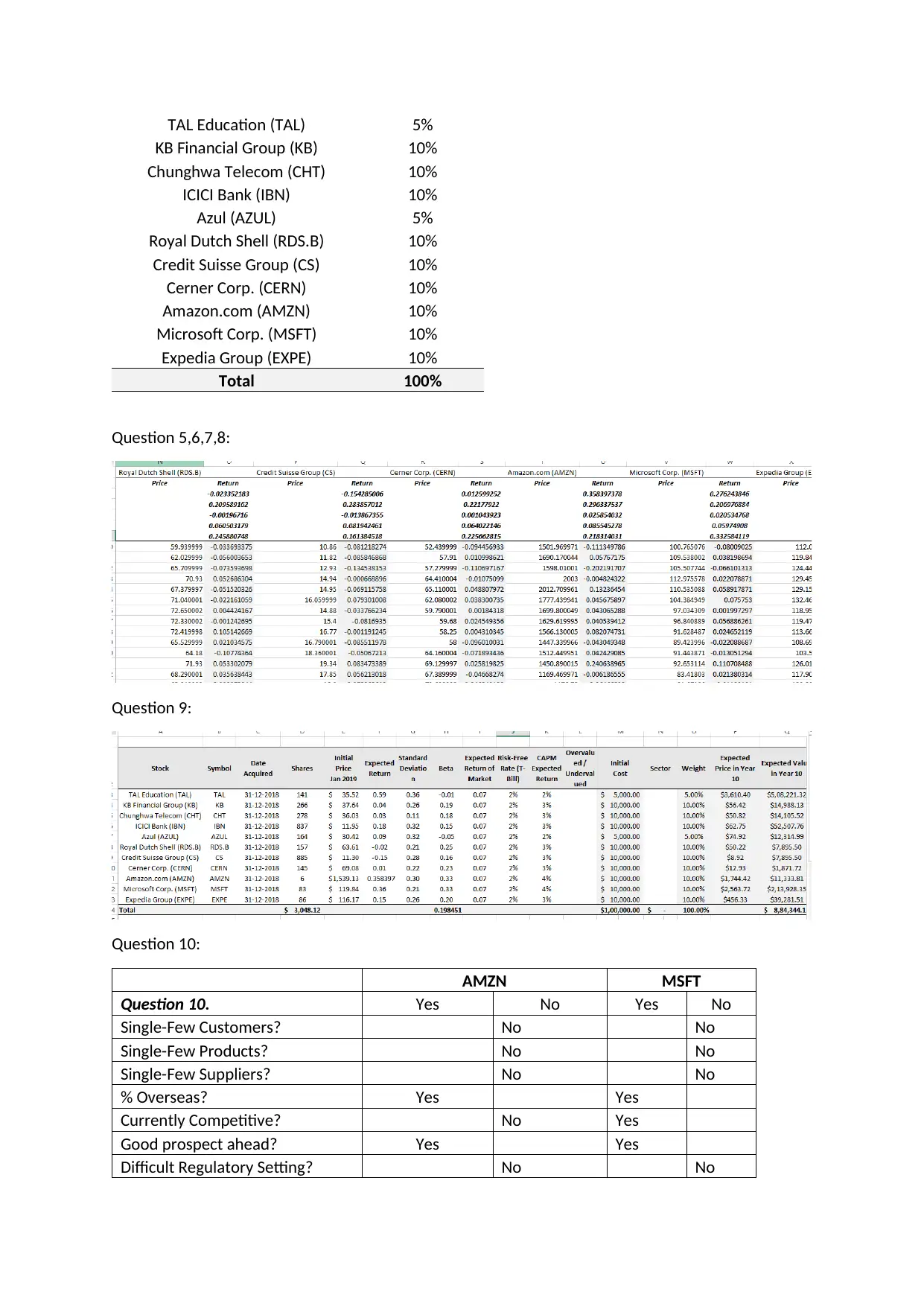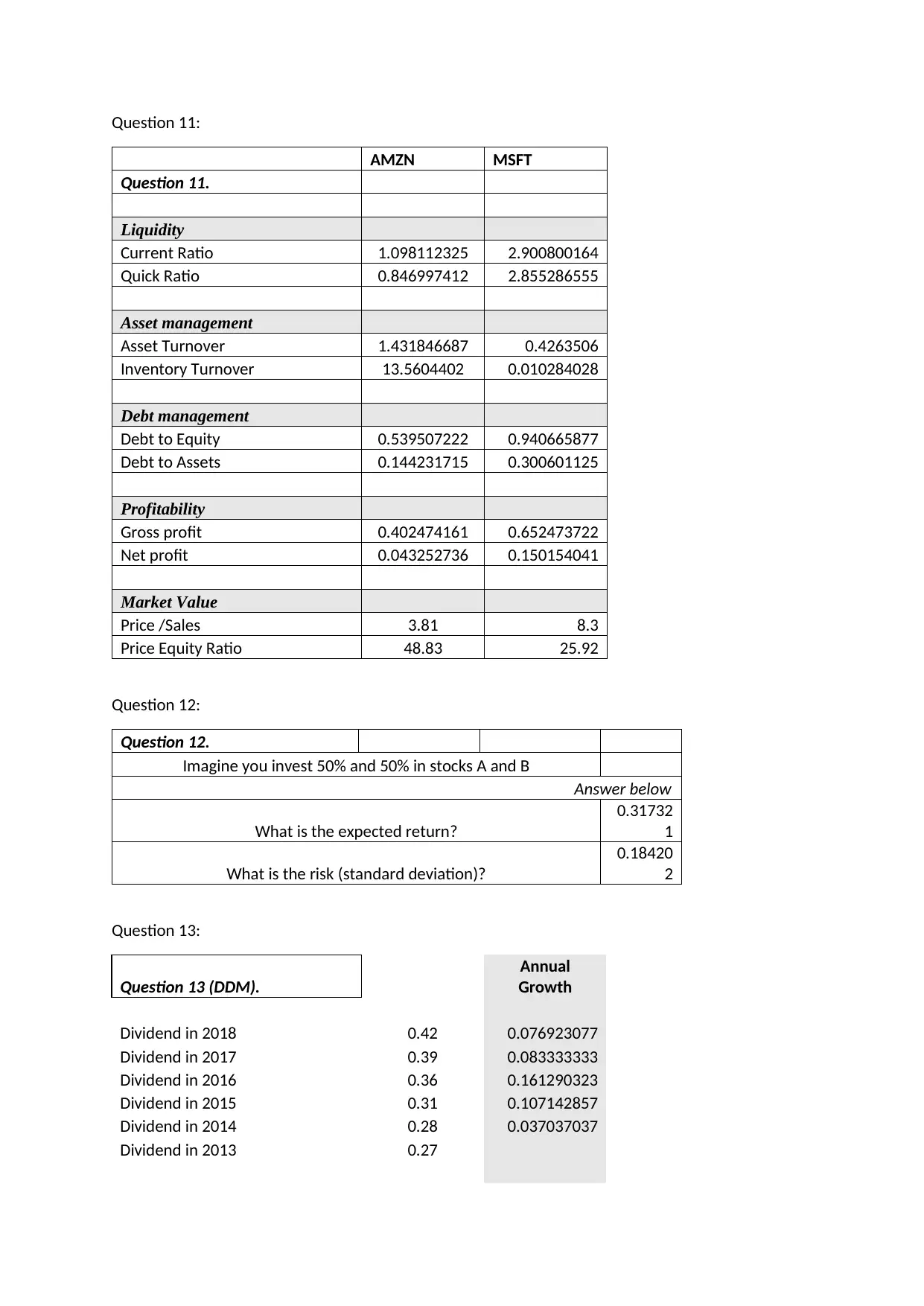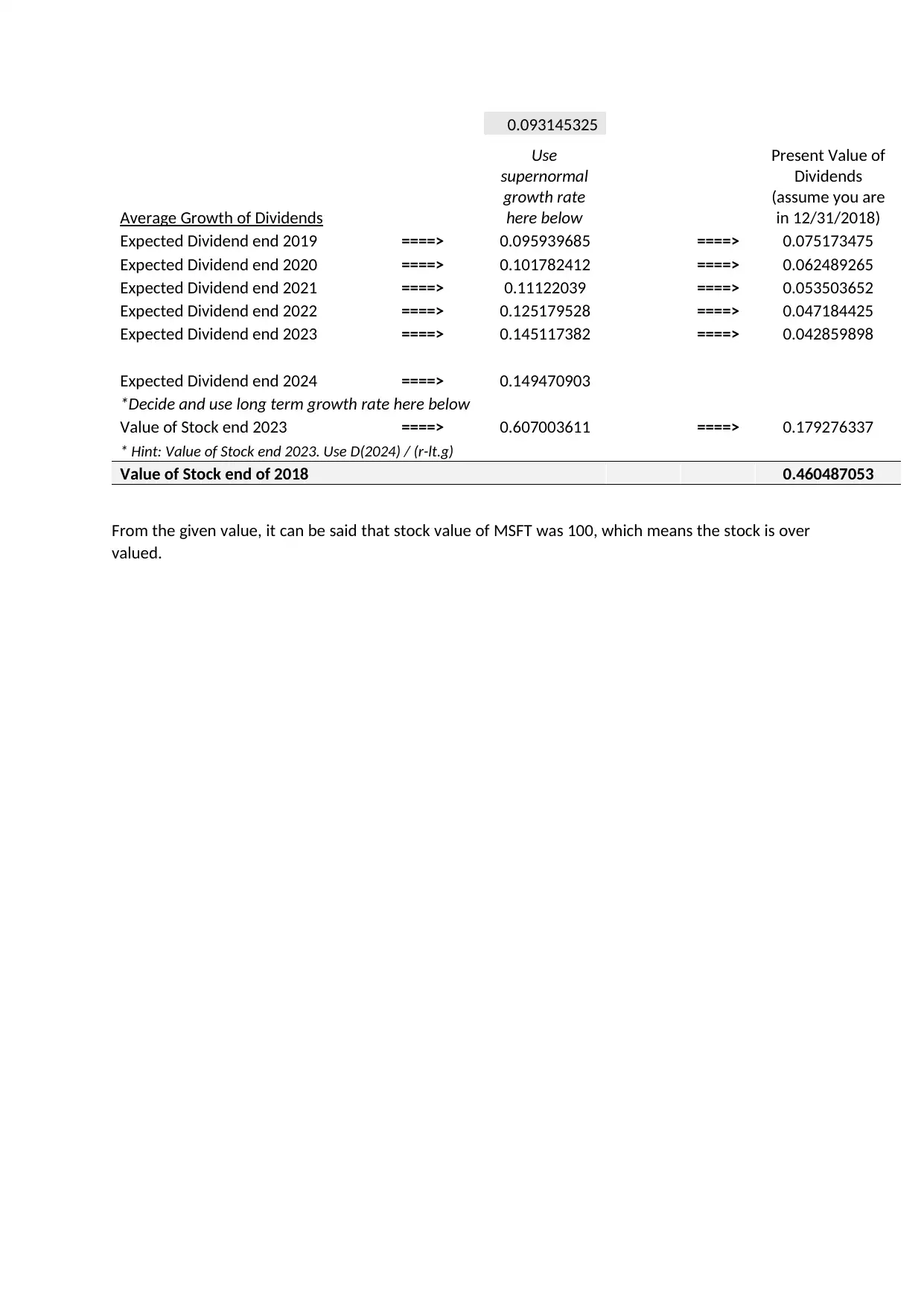FIN4502 Securities Analysis: A Comprehensive Portfolio Project
VerifiedAdded on 2022/12/26
|6
|1048
|95
Project
AI Summary
This project provides a broad overview of forming a $100,000 investment portfolio held for 10 years, implementing concepts from the FIN4502 Securities Analysis course. It emphasizes economic outlook, sector allocation (Materials, Information Technology, Consumer Staples, etc.), and stock selection (TAL Education, KB Financial Group, etc.) based on growth and value considerations. The analysis includes evaluating stocks like AMZN and MSFT, examining liquidity, asset management, debt management, and profitability ratios. Furthermore, it involves calculating expected returns and risks with a 50/50 investment strategy, applying the Dividend Discount Model (DDM) for stock valuation, and determining if stocks are over or undervalued. The project references academic sources for pricing models and investment fundamentals.

FIN4502 – SECURITIES ANALYSIS - FINAL PROJECT
Name of the Student
Name of the University
Author Note
Name of the Student
Name of the University
Author Note
Paraphrase This Document
Need a fresh take? Get an instant paraphrase of this document with our AI Paraphraser

Question 1:
Resource allotment ought to be fundamentally founded on the time accessible for the objective. On
the off chance that the value presentation is high, it should then consider different parameters, for
example, the financial specialist's age, hazard craving, chance taking capacity. Assume every one of
the objectives of a youthful financial specialist are long haul (8, 12 and 15 years). And, after it’s all
said and done, the whole distribution ought not to be to values. "The venture portfolio, paying little
heed to the time span, ought to be adjusted. Considering the given report of Goldman Sachs –
Global Economic Outlook 2019, the analyst has found that the GDP and inflation has significant
impact on stock performance level and which varies across regions. Thus, basis the report, the
analyst has aimed for 20% stocks from Europe, 45% from America and 35% from Asia. Moreover,
considering the risk taking abilities, the analyst has considered 35% stock to be chosen from
emerging economies and 65% from developed economy.
Question 2:
Hazard isn't consistently spread crosswise over money related markets and this reality can be
abused to diminish venture hazard adding to improve worldwide budgetary strength. We talk about
how, by removing the reliance structure of money related values, a system approach can be utilized
to manufacture a well-enhanced portfolio that successfully decreases speculation chance. We find
that interests in stocks that possess fringe, ineffectively associated areas in money related sifted
systems, to be specific Minimum Spanning Trees and Planar Maximally Filtered Graphs, are best in
differentiating, improving the proportion between returns' normal and standard deviation, lessening
the probability of negative returns, while keeping benefits in accordance with the general market
normal notwithstanding for little bins of stocks. Despite what might be expected, interests in subsets
of focal, exceptionally associated stocks are described by more serious hazard and more terrible
execution. This philosophy has the additional bit of leeway of picturing portfolio decisions
legitimately over the realistic design of the system. Here, the analyst has considered below sectors:
Materials 0%
Information Technology 20%
Consumer Staples 5%
Industrials 0%
Healthcare 0%
Financials 30%
Energy 10%
Consumer Discretionary 0%
Utilities 25%
Real Estate 0%
Communication Services 10%
Total 100%
Question 3:
The analyst has focused on growth portfolio and thus has considered 75% growth stocks and 25%
valued stock while preparing the portfolio.
Question 4:
Chosen stocks:
Resource allotment ought to be fundamentally founded on the time accessible for the objective. On
the off chance that the value presentation is high, it should then consider different parameters, for
example, the financial specialist's age, hazard craving, chance taking capacity. Assume every one of
the objectives of a youthful financial specialist are long haul (8, 12 and 15 years). And, after it’s all
said and done, the whole distribution ought not to be to values. "The venture portfolio, paying little
heed to the time span, ought to be adjusted. Considering the given report of Goldman Sachs –
Global Economic Outlook 2019, the analyst has found that the GDP and inflation has significant
impact on stock performance level and which varies across regions. Thus, basis the report, the
analyst has aimed for 20% stocks from Europe, 45% from America and 35% from Asia. Moreover,
considering the risk taking abilities, the analyst has considered 35% stock to be chosen from
emerging economies and 65% from developed economy.
Question 2:
Hazard isn't consistently spread crosswise over money related markets and this reality can be
abused to diminish venture hazard adding to improve worldwide budgetary strength. We talk about
how, by removing the reliance structure of money related values, a system approach can be utilized
to manufacture a well-enhanced portfolio that successfully decreases speculation chance. We find
that interests in stocks that possess fringe, ineffectively associated areas in money related sifted
systems, to be specific Minimum Spanning Trees and Planar Maximally Filtered Graphs, are best in
differentiating, improving the proportion between returns' normal and standard deviation, lessening
the probability of negative returns, while keeping benefits in accordance with the general market
normal notwithstanding for little bins of stocks. Despite what might be expected, interests in subsets
of focal, exceptionally associated stocks are described by more serious hazard and more terrible
execution. This philosophy has the additional bit of leeway of picturing portfolio decisions
legitimately over the realistic design of the system. Here, the analyst has considered below sectors:
Materials 0%
Information Technology 20%
Consumer Staples 5%
Industrials 0%
Healthcare 0%
Financials 30%
Energy 10%
Consumer Discretionary 0%
Utilities 25%
Real Estate 0%
Communication Services 10%
Total 100%
Question 3:
The analyst has focused on growth portfolio and thus has considered 75% growth stocks and 25%
valued stock while preparing the portfolio.
Question 4:
Chosen stocks:

TAL Education (TAL) 5%
KB Financial Group (KB) 10%
Chunghwa Telecom (CHT) 10%
ICICI Bank (IBN) 10%
Azul (AZUL) 5%
Royal Dutch Shell (RDS.B) 10%
Credit Suisse Group (CS) 10%
Cerner Corp. (CERN) 10%
Amazon.com (AMZN) 10%
Microsoft Corp. (MSFT) 10%
Expedia Group (EXPE) 10%
Total 100%
Question 5,6,7,8:
Question 9:
Question 10:
AMZN MSFT
Question 10. Yes No Yes No
Single-Few Customers? No No
Single-Few Products? No No
Single-Few Suppliers? No No
% Overseas? Yes Yes
Currently Competitive? No Yes
Good prospect ahead? Yes Yes
Difficult Regulatory Setting? No No
KB Financial Group (KB) 10%
Chunghwa Telecom (CHT) 10%
ICICI Bank (IBN) 10%
Azul (AZUL) 5%
Royal Dutch Shell (RDS.B) 10%
Credit Suisse Group (CS) 10%
Cerner Corp. (CERN) 10%
Amazon.com (AMZN) 10%
Microsoft Corp. (MSFT) 10%
Expedia Group (EXPE) 10%
Total 100%
Question 5,6,7,8:
Question 9:
Question 10:
AMZN MSFT
Question 10. Yes No Yes No
Single-Few Customers? No No
Single-Few Products? No No
Single-Few Suppliers? No No
% Overseas? Yes Yes
Currently Competitive? No Yes
Good prospect ahead? Yes Yes
Difficult Regulatory Setting? No No
⊘ This is a preview!⊘
Do you want full access?
Subscribe today to unlock all pages.

Trusted by 1+ million students worldwide

Question 11:
AMZN MSFT
Question 11.
Liquidity
Current Ratio 1.098112325 2.900800164
Quick Ratio 0.846997412 2.855286555
Asset management
Asset Turnover 1.431846687 0.4263506
Inventory Turnover 13.5604402 0.010284028
Debt management
Debt to Equity 0.539507222 0.940665877
Debt to Assets 0.144231715 0.300601125
Profitability
Gross profit 0.402474161 0.652473722
Net profit 0.043252736 0.150154041
Market Value
Price /Sales 3.81 8.3
Price Equity Ratio 48.83 25.92
Question 12:
Question 12.
Imagine you invest 50% and 50% in stocks A and B
Answer below
What is the expected return?
0.31732
1
What is the risk (standard deviation)?
0.18420
2
Question 13:
Question 13 (DDM).
Annual
Growth
Dividend in 2018 0.42 0.076923077
Dividend in 2017 0.39 0.083333333
Dividend in 2016 0.36 0.161290323
Dividend in 2015 0.31 0.107142857
Dividend in 2014 0.28 0.037037037
Dividend in 2013 0.27
AMZN MSFT
Question 11.
Liquidity
Current Ratio 1.098112325 2.900800164
Quick Ratio 0.846997412 2.855286555
Asset management
Asset Turnover 1.431846687 0.4263506
Inventory Turnover 13.5604402 0.010284028
Debt management
Debt to Equity 0.539507222 0.940665877
Debt to Assets 0.144231715 0.300601125
Profitability
Gross profit 0.402474161 0.652473722
Net profit 0.043252736 0.150154041
Market Value
Price /Sales 3.81 8.3
Price Equity Ratio 48.83 25.92
Question 12:
Question 12.
Imagine you invest 50% and 50% in stocks A and B
Answer below
What is the expected return?
0.31732
1
What is the risk (standard deviation)?
0.18420
2
Question 13:
Question 13 (DDM).
Annual
Growth
Dividend in 2018 0.42 0.076923077
Dividend in 2017 0.39 0.083333333
Dividend in 2016 0.36 0.161290323
Dividend in 2015 0.31 0.107142857
Dividend in 2014 0.28 0.037037037
Dividend in 2013 0.27
Paraphrase This Document
Need a fresh take? Get an instant paraphrase of this document with our AI Paraphraser

0.093145325
Average Growth of Dividends
Use
supernormal
growth rate
here below
Present Value of
Dividends
(assume you are
in 12/31/2018)
Expected Dividend end 2019 ====> 0.095939685 ====> 0.075173475
Expected Dividend end 2020 ====> 0.101782412 ====> 0.062489265
Expected Dividend end 2021 ====> 0.11122039 ====> 0.053503652
Expected Dividend end 2022 ====> 0.125179528 ====> 0.047184425
Expected Dividend end 2023 ====> 0.145117382 ====> 0.042859898
Expected Dividend end 2024 ====> 0.149470903
*Decide and use long term growth rate here below
Value of Stock end 2023 ====> 0.607003611 ====> 0.179276337
* Hint: Value of Stock end 2023. Use D(2024) / (r-lt.g)
Value of Stock end of 2018 0.460487053
From the given value, it can be said that stock value of MSFT was 100, which means the stock is over
valued.
Average Growth of Dividends
Use
supernormal
growth rate
here below
Present Value of
Dividends
(assume you are
in 12/31/2018)
Expected Dividend end 2019 ====> 0.095939685 ====> 0.075173475
Expected Dividend end 2020 ====> 0.101782412 ====> 0.062489265
Expected Dividend end 2021 ====> 0.11122039 ====> 0.053503652
Expected Dividend end 2022 ====> 0.125179528 ====> 0.047184425
Expected Dividend end 2023 ====> 0.145117382 ====> 0.042859898
Expected Dividend end 2024 ====> 0.149470903
*Decide and use long term growth rate here below
Value of Stock end 2023 ====> 0.607003611 ====> 0.179276337
* Hint: Value of Stock end 2023. Use D(2024) / (r-lt.g)
Value of Stock end of 2018 0.460487053
From the given value, it can be said that stock value of MSFT was 100, which means the stock is over
valued.

Bibliography
Belze, L., Larmande, F. and Schneider, L., 2016. Pricing model management: Evidence from
employee stock option (un) fair valuation. HEC Paris Research Paper No. ACC-2015-1103.
Edeki, S.O., Ugbebor, O.O. and Owoloko, E.A., 2016. He’s polynomials for analytical solutions
of the Black-Scholes pricing model for stock option valuation.
Jordan, B.D., Miller, T.W. and Dolvin, S.D., 2015. Fundamentals of investments: valuation
and management. McGraw-Hill Education.
Ni, Z.X., Wang, D.Z. and Xue, W.J., 2015. Investor sentiment and its nonlinear effect on stock
returns—New evidence from the Chinese stock market based on panel quantile regression
model. Economic Modelling, 50, pp.266-274.
Belze, L., Larmande, F. and Schneider, L., 2016. Pricing model management: Evidence from
employee stock option (un) fair valuation. HEC Paris Research Paper No. ACC-2015-1103.
Edeki, S.O., Ugbebor, O.O. and Owoloko, E.A., 2016. He’s polynomials for analytical solutions
of the Black-Scholes pricing model for stock option valuation.
Jordan, B.D., Miller, T.W. and Dolvin, S.D., 2015. Fundamentals of investments: valuation
and management. McGraw-Hill Education.
Ni, Z.X., Wang, D.Z. and Xue, W.J., 2015. Investor sentiment and its nonlinear effect on stock
returns—New evidence from the Chinese stock market based on panel quantile regression
model. Economic Modelling, 50, pp.266-274.
⊘ This is a preview!⊘
Do you want full access?
Subscribe today to unlock all pages.

Trusted by 1+ million students worldwide
1 out of 6
Your All-in-One AI-Powered Toolkit for Academic Success.
+13062052269
info@desklib.com
Available 24*7 on WhatsApp / Email
![[object Object]](/_next/static/media/star-bottom.7253800d.svg)
Unlock your academic potential
Copyright © 2020–2025 A2Z Services. All Rights Reserved. Developed and managed by ZUCOL.